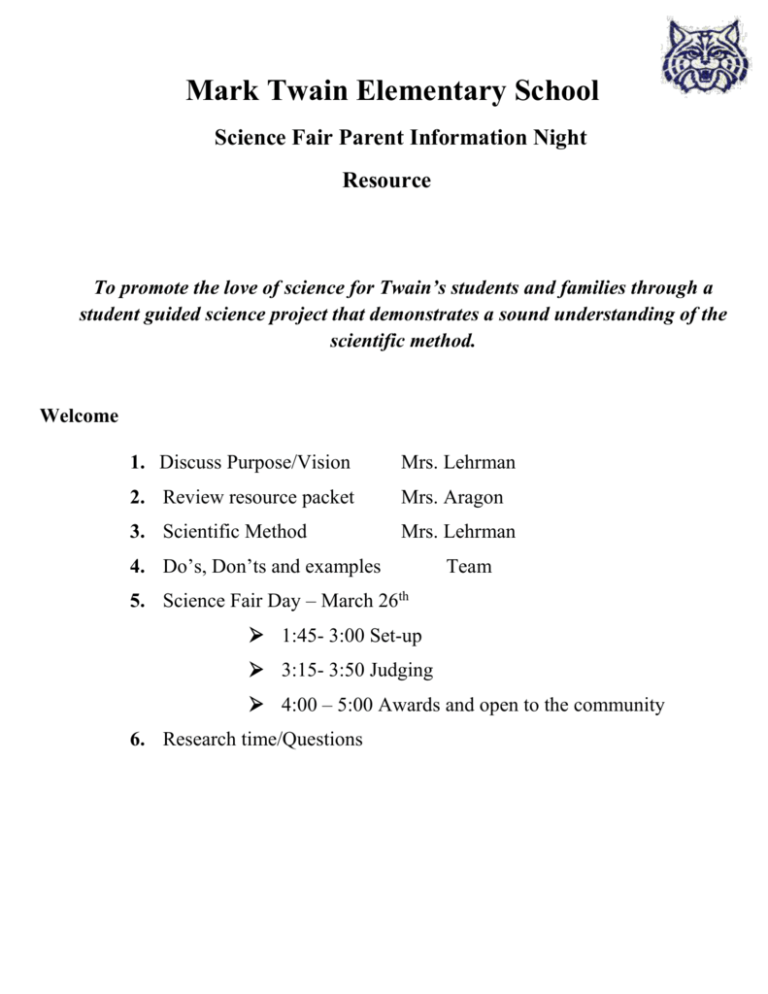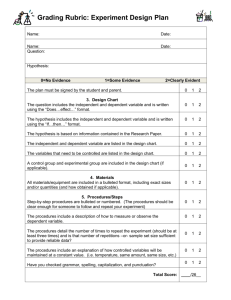Mark Twain Annual Science Fair grades K-5
advertisement

Mark Twain Elementary School Science Fair Parent Information Night Resource To promote the love of science for Twain’s students and families through a student guided science project that demonstrates a sound understanding of the scientific method. Welcome 1. Discuss Purpose/Vision Mrs. Lehrman 2. Review resource packet Mrs. Aragon 3. Scientific Method Mrs. Lehrman 4. Do’s, Don’ts and examples Team 5. Science Fair Day – March 26th 1:45- 3:00 Set-up 3:15- 3:50 Judging 4:00 – 5:00 Awards and open to the community 6. Research time/Questions Mark Twain Elementary School 2014 Science Fair Packet Science Fair March 26, 2014 at Mark Twain How to Select a Science Project Topic Sometimes one of the hardest things about a science project is selecting a topic! Here are a few things to keep in mind when selecting a topic: Choose something you are interested in Ask your family for ideas Think of something you already know a little about Think about types of materials you already have at your home Think about questions you have about the world around you. What are you wondering about? If a topic still hasn’t come to mind, check out some of the Web sites listed below. Students are allowed to choose any topic they would like as long as it follows these rules: All projects must follow the scientific method* and test a hypothesis. No displays or demonstration projects, for example, no volcano demonstrations. Students may work by themselves, or with one other student from the same grade level. A student’s project should reflect his/her age and ability level. All investigations must be supervised by an adult. Glass, flames, live animals, and hazardous chemicals will not be allowed as part of a student’s display. What does the Scientific Method look like? The scientific method is a process for experimentation that is used to explore observations and answer questions. Scientists use the scientific method to search for cause and effect relationships in nature. In other words, they design an investigation so that changes to one item cause something else to vary in a predictable way. Just as it does for a professional scientist, the scientific method will help you to focus your science fair project question, construct a hypothesis, design, execute, and evaluate your investigation. Steps of the Scientific Method Ask a Question: The scientific method starts when you ask a question about something that you observe: How, What, When, Who, Which, Why, or Where? And, in order for the scientific method to answer the question it must be about something that you can measure, preferably with a number. Do Background Research: Rather than starting from scratch in putting together a plan for answering your question, you want to be a savvy scientist using library and Internet research to help you find the best way to do things and insure that you don't repeat mistakes from the past. Construct a Hypothesis: A hypothesis is an educated guess about how things work: "If _____[I do this] _____, then _____[this]_____ will happen." You must state your hypothesis in a way that you can easily measure, and of course, your hypothesis should be constructed in a way to help you answer your original question. Test Your Hypothesis by Doing an Investigation: Your investigation tests whether your hypothesis is true or false. It is important for your investigation to be a fair test. You conduct a fair test by making sure that you change only one factor at a time while keeping all other conditions the same. You should also repeat your investigations several times to make sure that the first results weren't just an accident. Analyze Your Data and Draw a Conclusion: Once your investigation is complete, you collect your measurements and analyze them to see if your hypothesis is true or false. Scientists often find that their hypothesis was false, and in such cases they will construct a new hypothesis starting the entire process of the scientific method over again. Even if they find that their hypothesis was true, they may want to test it again in a new way. Communicate Your Results: To complete your science fair project you will communicate your results to others in a final report and/or a display board. Professional scientists do almost exactly the same thing by publishing their final report in a scientific journal or by presenting their results on a poster at a scientific meeting. Mark Twain Annual Science Fair grades K-5 Science Fair Project Display Board Information: Your Display Board is due on: Wednesday, March 26th in the gym. Students will set-up their own Science Fair Project Display Boards 1:45-3 PM. Why create a display board? A display board communicates your work to others. Materials: Collect a 36” x 48” three-panel self standing display board. Extra strength glue sticks, rubber cement glue or double stick tape hold the papers upright onto the board without peeling off. Add simple visual accents to your board. Use colored construction paper to create colorful boarders. However, do not make board to busy with color, glitter or die cuts that will make it difficult to read. Cardstock or heavy weight paper used will decrease the chance of your glued information looking wrinkled or bubbled. How? Draw a sketch of your board. Organize it like a newspaper so that it is easy for the readers to follow your experiment. It should be laid out to read from the top of the board to the bottom and then from left to right side of the board. Double check that you include each step of your scientific method displayed on the board. Check that you included your first and last name and grade level. Proof read and edit before you glue/paste and turn in your finished project display board. A Science Fair Project Display Board Checklist can be found at www.sciencebuddies.org/science-fair-projects/project_display_noard.shtml Type: 16 point fonts or larger when typing your display board and titles maybe larger font. Don’t forget to Title: Should be neatly centered, big font and easy to read. Create an attention getting title that also accurately describes your experiment. Pictures: Use graphics (graphs, pictures and tables) help grab the readers attention and can further explain your experiment. Do not place words over pictures as it makes it hard for the reader to read. Sources: Do not forget to include acknowledgements and sources cited. Abstract ………… …………. ………… Question ………………… ………………… Hypothe ………………… ………………… Backgroun d ………… …………. ………… Project Title By : student first and last name, Materials ………… …………. ………… …………… ……….…… …… Procedure 1………… … 2.…….… 5………… …… 6..….…… Results 10 Se 0 r… Category 1 Information collected from www.sciencebuddies.org Conclusi ………… …………. ………… …………. ………… Future Direction ………… …………. ………… Sources Cited/ Acknowledgeme …………… ……….… Mark Twain’s Annual Science Fair grades K-5 Preparing for Science Fair Judging Judges will not judge you on your presentation. However, the information and effort that you provide will help create a further understanding of your experiment. Plan ahead! Prepare for success Practice sharing your experiment with others, answering their questions and explaining your project board to them. As you get more confident in your presentation abilities practice greeting a family member or friend with introducing yourself “hello, my name is ……” then give them a firm handshake “my science fair project is titled ………….” and then conduct your presentation. Practice standing to the side of the project board with your shoulders facing your audience. Point to the information and graphics as you discuss it. Practice good eye contact, a mega watt smile and a voice that demonstrates confidence in your own fantastic experiment. Practice sharing your uniqueness by explaining your creative choices you used in your project, this shows ownership of your project to the judges. Attire: No jeans, plan on wearing a nice school appropriate professional looking outfit On the day of the science fair: Wednesday, March 26, 2014 It’s show time Wear your smile and always be respectful to all (judges, parents, and classmates). Give good eye contact to judges and be confident while you present. Talk loud enough for judges to hear and try not to mumble. If you do not understand the judge’s question you can ask them to give you an example or repeat the question. If you do not know the answer to their question it is good to be honest and state “I do not know at this time.” Make sure to collect your rubric and review it. After the science fair is over you are welcome to respectively ask judges for feedback. Remember this is a fun learning experience and so take the time to learn from what you did well and what you would like to improve on for next year. Congratulations on challenging yourself by participating in this year’s science fair! Remember to thank parents/guardians, teachers or older siblings who helped you along this challenging project. Good luck scientist at next year’s science fair!









